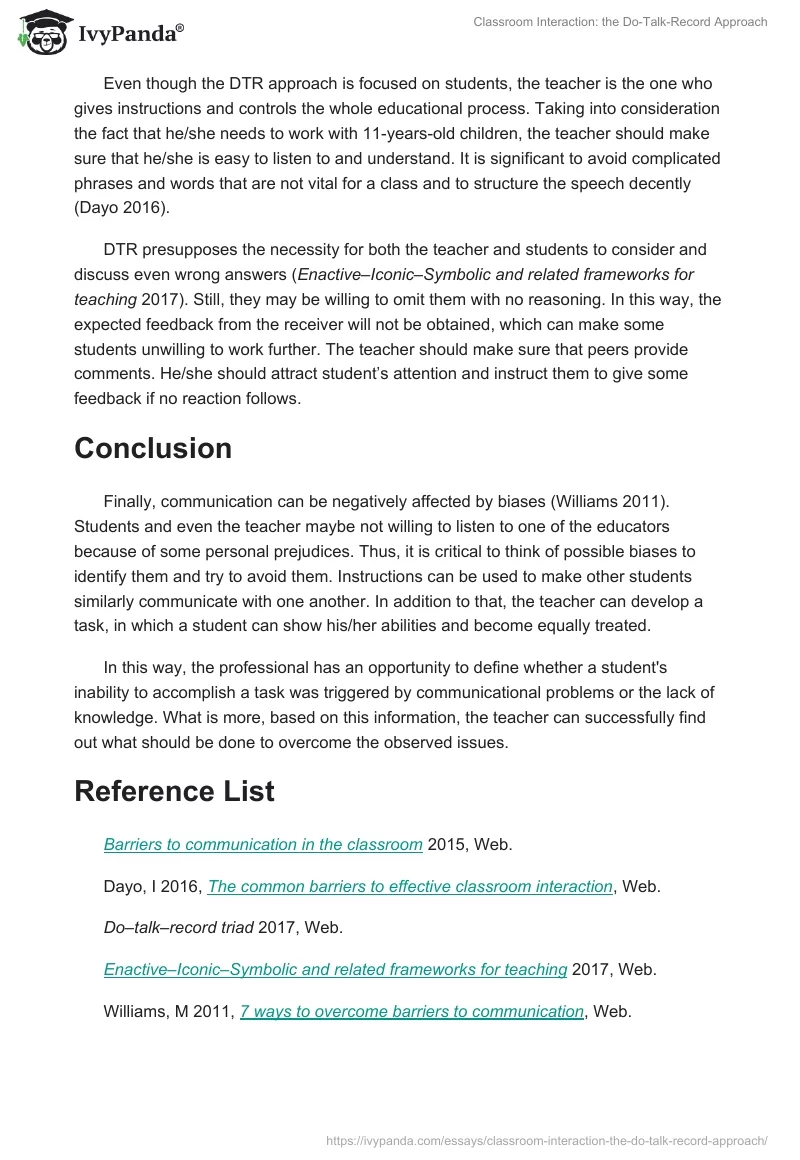Introduction
The do-talk-record (DTR) approach was developed to engage learners in collaborative practices while working in mathematics classrooms. According to it, students accomplish a task, discuss it with one another, and then make records. This approach is targeted at learners mainly so that the educator does not have much influence on the process (Do–talk–record triad 2017). Thus, the teacher must consider the possibility of facing some communicational issues.
Moving from recording to completing tasks
The teacher may be too focused on the sequence of events that should be maintained when using the DTR framework so that the interaction can be limited only to it. As a result, classroom communication will be rather boring. Losing interest, students will not be willing to continue working hard. To avoid this situation, the teacher should resort to some creative tasks and remember that it is not critical to follow all steps in a particular order. All interactions and tasks are different, so there will be an opportunity to implement changes and move from recording back to doing, for instance.
Personality differences should be taken into consideration (Barriers to communication in the classroom 2015). Some students may be introverts for whom discussing something with others is not an easy task. Even knowing what to say, they may be unwilling to take the initiative and start a conversation. Thus, the teacher should try to gather students in groups so that they are balanced and no one is suppressed.
Communication may be ineffective if the educator streamlines interaction. Not all students can discuss their work while doing it or as soon as it is done. As a result, they may be confused and fail to grasp the information. So teachers need to allow their students to think and reflect on results at least for several minutes.
Even though the DTR approach is focused on students, the teacher is the one who gives instructions and controls the whole educational process. Taking into consideration the fact that he/she needs to work with 11-years-old children, the teacher should make sure that he/she is easy to listen to and understand. It is significant to avoid complicated phrases and words that are not vital for a class and to structure the speech decently (Dayo 2016).
DTR presupposes the necessity for both the teacher and students to consider and discuss even wrong answers (Enactive–Iconic–Symbolic and related frameworks for teaching 2017). Still, they may be willing to omit them with no reasoning. In this way, the expected feedback from the receiver will not be obtained, which can make some students unwilling to work further. The teacher should make sure that peers provide comments. He/she should attract student’s attention and instruct them to give some feedback if no reaction follows.
Conclusion
Finally, communication can be negatively affected by biases (Williams 2011). Students and even the teacher maybe not willing to listen to one of the educators because of some personal prejudices. Thus, it is critical to think of possible biases to identify them and try to avoid them. Instructions can be used to make other students similarly communicate with one another. In addition to that, the teacher can develop a task, in which a student can show his/her abilities and become equally treated.
In this way, the professional has an opportunity to define whether a student’s inability to accomplish a task was triggered by communicational problems or the lack of knowledge. What is more, based on this information, the teacher can successfully find out what should be done to overcome the observed issues.
Reference List
Barriers to communication in the classroom. 2015. Web.
Dayo, I 2016, The common barriers to effective classroom interaction. Web.
Do–talk–record triad. 2017. Web.
Enactive–Iconic–Symbolic and related frameworks for teaching. 2017. Web.
Williams, M 2011, 7 ways to overcome barriers to communication. Web.


